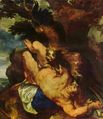
Guild of Romanists
Encyclopedia

Renaissance humanism
Renaissance humanism was an activity of cultural and educational reform engaged by scholars, writers, and civic leaders who are today known as Renaissance humanists. It developed during the fourteenth and the beginning of the fifteenth centuries, and was a response to the challenge of Mediæval...
and artist
Artist
An artist is a person engaged in one or more of any of a broad spectrum of activities related to creating art, practicing the arts and/or demonstrating an art. The common usage in both everyday speech and academic discourse is a practitioner in the visual arts only...
s; it was a condition of membership that the member had visited Rome
Rome
Rome is the capital of Italy and the country's largest and most populated city and comune, with over 2.7 million residents in . The city is located in the central-western portion of the Italian Peninsula, on the Tiber River within the Lazio region of Italy.Rome's history spans two and a half...
. Deans were appointed annually. It was "where 'art-pilgrims' met to keep themselves up to date on news from Rome, whether it be new painters or paintings, or newly discovered antiquities". It appears to have acted in some sense as an alternative to the long-established Antwerp painters' Guild of Saint Luke
Guild of Saint Luke
The Guild of Saint Luke was the most common name for a city guild for painters and other artists in early modern Europe, especially in the Low Countries. They were named in honor of the Evangelist Luke, the patron saint of artists, who was identified by John of Damascus as having painted the...
, to which all or most of its members also belonged, as his membership of the Romanists is given (together with his appointment as a Court painter) as a reason for Rubens being only made an honorary Dean of the Guild of St Luke.
The condition of having visited Rome to enjoy membership appears to have been strictly enforced, as art historians accept membership of the Guild as evidence of travels that are (in the case of Fyt etc) otherwise undocumented.
The Renaissance movement of Romanism
Romanism (painting)
Romanism was the style of painting of a group of artists in the late 15th and early 16th century from the Netherlands who began to visit Italy and started to incorporate Renaissance influences in their work. The greatest artist in the style was Jan Mabuse...
in Netherlandish painting was reaching the end of its main period when the society began, but it probably paid a part in promoting the strong links between Italian and Flemish art in the Baroque period, under the dominating influence of Rubens.
Notable members
- Marten de VosMarten de VosMarten de Vos , also Maarten, was a leading Antwerp painter and draughtsman in the late sixteenth century.-Biography:Like Frans Floris, he travelled to Italy and adopted the mannerist style popular at the time. De Vos was also highly influenced by the colors of Venetian painting, and might have...
- Founder - Jan Brueghel the ElderJan Brueghel the ElderJan Brueghel the Elder was a Flemish painter, son of Pieter Bruegel the Elder and father of Jan Brueghel the Younger. Nicknamed "Velvet" Brueghel, "Flower" Brueghel, and "Paradise" Brueghel, of which the latter two were derived from his floral still lifes which were his favored subjects, while the...
,1599 - Otto van VeenOtto van VeenOtto van Veen, also known by his Latinized name Otto Venius or Octavius Vaenius, was a painter, draughtsman, and humanist active primarily in Antwerp and Brussels in the late sixteenth and early seventeenth century...
, Dean 1606 - Abraham JanssensAbraham JanssensAbraham Janssens van Nuyssen was a Flemish Baroque painter.He was born at Antwerp, in a year variously reported between 1567 and 1576. He studied under Jan Snellinck, was a master in 1602, and in 1607 was dean of the master-painters...
, 1610 or 1601 - Hendrick van BalenHendrick van BalenHendrik van Balen was a Flemish Baroque painter.-Biography:Van Balen was born and died in Antwerp. He was a pupil of Adam van Noort and studied art while traveling in Italy...
, Dean 1613 - Pieter Paul Rubens, 1609, Dean 1613-14
- Frans Snyders, 1619, Dean 1629
- Jan FytJan FytJan Fyt was a Flemish Baroque animal painter and etcher.-Life:...
, 1650, Dean 1652 - Wenceslas CobergherWenceslas CobergherWenceslas Cobergher , sometimes called Wenzel Coebergher, was a Flemish Renaissance architect, engineer, painter, antiquarian, numismatist and economist. Faded somewhat into the background as a painter, he is chiefly remembered today as the man responsible for the draining of the Moëres on the...
, 1605
See also
- Chamber of rhetoricChamber of rhetoricChambers of rhetoric were dramatic societies in the Low Countries. Their members are called Rederijkers , from the french word 'rhétoricien', and during the 15th and 16th centuries were mainly interested in dramas and lyrics...
- Antwerp schoolAntwerp schoolThe Antwerp School is a term for the artists active in Antwerp, first during the 16th century when the city was the economic center of the Low Countries, and then during the 17th century when it became the artistic stronghold of the Flemish Baroque under Peter Paul Rubens.-History:Antwerp took over...
- BentvueghelsBentvueghelsThe Bentvueghels were a society of mostly Dutch and Flemish artists active in Rome from about 1620 to 1720. They are also known as the Schildersbent .-Activities:...
Netherlandish artists' society in Rome

